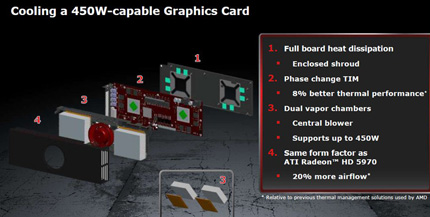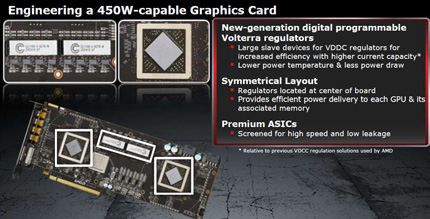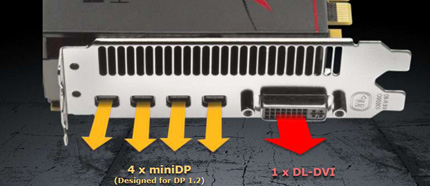Blow me! How to cool a monster
A piddly heatsink simply isn't going to cut it, no, sir. What's needed here is a real manly cooler that laughs in the face of dissipating 250W. Heck, it won't get out of bed unless there's 400W knockin' on the door.
One benefit of having a super-long card - the Radeon HD 6990 has a 12in PCB - is that engineers have a lot of room to play with. Going from top to bottom, the card-long cooler uses a centrally-mounted fan with vapour chambers on each side: yup, Radeon HD 6990 has two. According to AMD's experts, this arrangement, coupled with apportioning an entire slot on the I/O section, primarily for heat-exhausting purposes, provides around 20 per cent more airflow to the GPUs.
But when there's so much potential heat to shift, every facet of cooling needs to be taken into account. Out goes the namby-pamby thermal tape and in comes phase-changing thermal interface material, which is designed to turn into a sticky, gloopy mixture once the card heats up. The premise is to fill every nook and cranny between the GPUs/memory and heatsinks. AMD's tests show that this improves thermal performance by up to eight per cent.
You know, we believe it's high time that watercooling was brought in as de facto cooling for super-high-end cards. AMD seems to disagree for now, at least.
Now looking closely at the PCB, ploughing a familiar theme, delivering 450W-plus power is no easy task. It's not been done before on a consumer graphics card. AMD positions the majority of the heat-producing ASICs into the middle of the board in a symmetrical layout. The basic structure is the same as the single-GPU Radeon HD 6970, which also uses Volterra regulators. Here, though, there's double trouble, and it's only the (comparatively) enviable power-draw characteristics of the very finest Cayman GPUs - remember, the ones found here are the pick of the bunch, operating at high speeds with low-ish voltage - that enable this card to see the light of day.
Cooling is also dictated by the constraint imposed by having a dual-slot cooler. We've seen ASUS ship with a triple-slot solution, which is just crazy, and the engineering job would be easier if this was the case here, but AMD wants to keep to a standard form factor.
A single row for outputs, then, leads to port sacrifices. AMD would love to have six mini-DisplayPort v1.2 ports hanging off this card, driving an Eyefinity6 array, but there's only room for four if taking the solitary dual-DVI port into account. This means that, out of the box, the Radeon HD 6990 can drive five monitors - boo hoo if you've got six - while adding another will require mini-DisplayPort adapters and hubs, which, at the time of writing, are reckoned to surface in H2 2011.
You know, if it was us, we'd throw in six mini-DP ports and a couple of active adapters.












